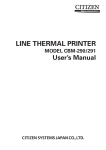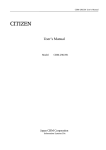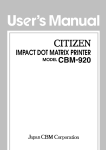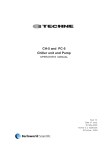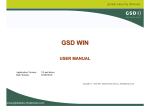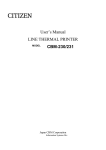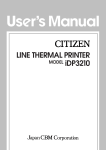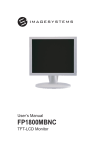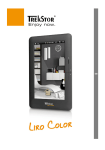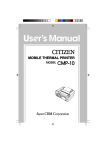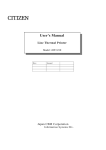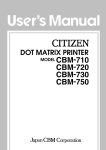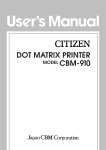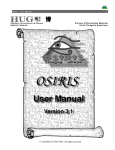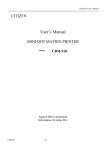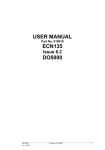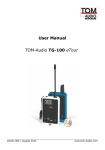Download cautions - CGP Electronics Kft.
Transcript
CBM-290/291 User’s Manual
Declaration of Conformity
Manufacturer’s Name :
Manufacturer’s Address
Declare the Product
Product Name
Model Number(s)
Conform to the following Standards
LVD
EMC
: Japan CBM Corporation
: CBM Bldg., 5-68-10, Nakano, Nakano-ku,
Tokyo, 164-0001, Japan
Line Thermal Printer
CBM-290/291
(S.No. 00Z0001 ~
)
: EN60950
: EN55022
: EN55024
: EN61000-4-2
: EN61000-4-3
: EN61000-4-4
: EN61000-4-5
: EN61000-4-6
: EN61000-4-11
: A3:1995
: 1998 Class A
: 1998
: 1995 ±4KV CD, ±8KV AD
: 1995 3V/m (AM 80%, 1KHz)
: 1995 ±1.0KV(AC Mains), ±0.5KV(Signal Lines)
: 1995 ±1KV (Normal mode), ±2KV (Common mode)
: 1996 3V, 0.15MHz-80MHz AM 1KHz 80%
: 1994 0%, 5000ms/ 70%, 500ms/ 0%, 10ms
Supplementary Information
“The product complies with the requirements of the Low Voltage Directive 73/23/EEC, 93/68/EEC and
the EMC Directive 89/336EEC, 92/31/EEC, 93/68EEC”
Place
Tokyo, Japan
Date
November, 2000
Signature
Full Name
Position
: Mikio Moriya
: General Manager
R & D Department
Europe Contact :
Norco Declaration AB
Box 7146 S-250 07 Helsingborg Sweden
Warning : This is a Class A products. In a domestic environment this product may cause radio interference in
which case the user may be required to take adequate measures.
This declaration is applied only for 230V model.
CITIZEN
CBM-290/291 User’s Manual
IMPORTANT SAFETY INSTRUCTIONS
•
•
•
•
•
•
•
•
•
•
•
•
•
Read all of these instructions and save them for later reference.
Follow all warnings and instructions marked on the product.
Unplug this product from the wall outlet before cleaning. Do not use liquid or aerosol cleaners. Use a
damp cloth for cleaning.
Do not use this product near water.
Do not place this product on an unstable cart, stand or table. The product may fall, causing serious
damage to the product.
Slots and openings on the cabinet and the back or bottom are provided for ventilation.
To ensure reliable operation of the product and to protect it from overheating, do not block or cover
these openings. The openings should never be blocked by placing the product on a bed, sofa, rug of
other similar surface. This product should never be placed near or over a radiator or heat register. This
product should never be placed near or over a radiator or heat register. This product should not be
placed in a built-in installation unless proper ventilation is provided.
This product should be operated from the type of power source indicated on the marking label. If you re
not sure of the type of power available, consult your dealer or local power company.
Do not allow anything to rest on the power cord. Do not locate this product where the cord will be
walked on.
If an extension cord is used with this product, make sure that the total of the ampere ratings on the
products plugged into the extension cord do not exceed the extension cord ampere rating. Also, make
sure that the total of all products plugged into the wall outlet does not exceed 15 amperes.
Never push objects of any kind into this product through cabinet slots as they may touch dangerous
voltage points or short out parts that could result in a risk of fire or electric shock. Never spill liquid of
any kind on the product.
Except as explained elsewhere in this manual, don’t attempt to service this product by yourself.
Opening and removing those covers that are marked “Do Not Remove” may expose you to dangerous
voltage points or other risks. Refer all servicing on those compartments to service personnel.
Unplug this product from the wall outlet and refer servicing to qualified service personnel under the
following conditions:
A. When the power cord or plug is damaged or frayed.
B. If liquid has been spilled into the product.
C. If the product has been exposed to rain or water.
D. If the product does not operate normally when the operating instructions are followed. Adjust only
those controls that are covered be the operating instructions since improper adjustment of other
controls may result in damage and will often require extensive work by a qualified technician to
restore the product to normal operation.
E. If the product has been dropped or the cabinet has been damaged.
F. If the product exhibits a distinct change in performance, indicating a need for service.
Please keep the poly bag which this equipment is packed in away from children or throw it away to
prevent children from putting it on. Putting it on may cause suffocation to them.
CITIZEN
CBM-290/291 User’s Manual
WICHTIGE SICHERHEITSANWEISUNGEN
•
•
•
•
•
•
•
•
•
•
•
Lesen Sie die nachfolgenden Anweisungen sorgfältig durch und bewahren Sie sie auf.
Befolgen Sie alle auf dem Drucker vermerkten Hinweise und Anweisungen. Vor dem Reinigen
grundsätzlich Stecker aus der Steckdose ziehen. Keine Flüssigkeiten oder Aerosolreiniger benutzen.
Nut mit einem feuchten Tuch abwischen.
Der Drucker darf nicht in der Nähe von Wasser aufgestellt werden.
Drucker nicht auf einem unstabilen Wagen, Stand oder Tisch aufstellen. Der Drucker könnte
herunterfallen und dabel beschädigt werden.
Schlitze und Öffnungen im Gehäuse, in der Rückwand und im Boden dienen der Belüftung. Sie dürfen
keinesfalls zugedeckt oder blockiert werden, da sich der Drucker sonst überhitzt. Drucker nicht auf
ein Bett, Sofa, Teppich oder dergleichen stellen. Drucker nicht in der Nähe eines Heizkörpers
aufstellen. Drucker darf nicht eingebaut werden, falls nicht für ausreichende Belüftung gesorgt ist.
Drucker nur mit der auf dem Typschild angegebenen Spannung betreiben. Wenn Sie sich nicht sicher
sind, fragen Sie ihren Händler oder ihr zuständiges Elektrizitätswerk.
Nichts auf das Stromanschlußkabel stellen. Kabel muß so verlegt werden, daß man nicht darauftreten
kann.
Ein etwaiges Verlängerungskabel muß der Stromstärke aller daran angeschlossenen Geräte entsprechen.
Keine Gegenstände in die Gehäuseschlitze schieben.
Drucker darf nur da gewartet werden, wo im Handbuch angegeben, Öffnen und. Abnehmen von
Abdeckungen, die mit “Do not remove” gekennzeichenet sind, könnte gefährliche spannungführende
Stellen oder sonstige Gefahrenpunkte freilegen. Die Wartung solcher Stellen darf grundsätzlich nur von
besonders ausgebildetem Fachpersonal vorgenommen werden.
A. Wenn das Stromanschlußkabel oder der Stecker beschädigt oder durch-gescheuert ist.
B. Wenn Flüssigkeit auf dem Drucker verschüttet wurde.
C. Wenn der Drucker im Regen gestanden hat oder Wasser darauf verschüttet wurde.
D. Wenn der Drucker trotz genauer Befolgung der Betriebsvorschriften nicht richtig arbeitet. Nur die in
der Bedienungsanleitung angegebenen Einstellungen vornehmen. Ein Verstellen anderer
Bedienungselemente könnte den Drucker beschädigen und macht umständliche Arbeiten eines
qualifizierten Technikers erforderlich, um den Drucker Wieder auf den normalen Betrieb
einzustellen.
E. Wenn der Drucker heruntergefallen ist oder das Gehäuse beschädigt wurde.
F.Wenn der Drucker in seiner Leistung nachläßt.
Bitte halten Sie den Kunststoffbeutel, in den die Ware verpackt ist, von Kindern entfernt, oder werfen
Sie ihn weg, damit er nicht in die Hande von Kindern gerät. Das Überstülpen des Beutels kann zum
Ersticken führen.
Lärmemission kleiner 70dBA
CITIZEN
CBM-290/291 User’s Manual
IMPORTANT: This equipment generates, uses, and can radiate radio frequency energy and if not
installed and used in accordance with the instruction manual, may cause interference to radio
communications. It has been tested and found to comply with the limits for a Class A computing device
pursuant to Subpart J of Part 15 off FCC Rules, which are designed to provide reasonable protection
against such interference when operated in a commercial environment. Operation of this equipment in a
residential area is likely to cause interference, in which case the user at his own expense will be required to
take whatever measures may be necessary to correct the interference.
CAUTION: Use shielded cable for this equipment.
Sicherheitshinweis
Die Steckdose zum Anschluß dieses Druckers muß nahe dem Grät angebracht und leicht zugänglich sein.
For Uses in Canada
This digital apparatus does not exceed the class A limits for radio noise emissions from digital, apparatus,
as set out in the radio interference regulations of the Canadian department of communications.
Pour L’utilisateurs Canadiens
Cet appareil numérique ne dépasse pas les limites de carégorie a pour les émissions de bruit radio émanant
d’appareils numériques, tel que prévu dans les réglements sur l’interférence radio du départment Canadien
des communications.
CITIZEN
CBM-290/291 User’s Manual
<CAUTIONS>
1. Prior to using the equipment, be sure to read this User's Manual thoroughly. Please keep it handy for reference
whenever it may be needed.
2. The information contained herein may be changed without prior notice.
3. Reproduction of part or all of this User's Manual without permission is strictly prohibited.
4. Never service, disassemble, or repair parts that are not mentioned in this User's Manual.
5. Note that we will not be responsible for damages attributable to a user's incorrect operation/ handling or an
improper operating environment.
6. Operate the equipment only as described in this User's Manual; otherwise accidents or problems may result.
7. Data are basically temporary; they cannot be stored or saved permanently or for a long time.
Please note that
we will not be responsible for damages or losses of profit resulting from losses of the data attributable to
accidents, repairs, tests, and so on.
8. If you have any questions or notice any clerical errors or omissions regarding the information in this manual,
please contact our office.
9. Please note that, notwithstanding Item 8 above, we will not be responsible for any effects resulting from
operation of the equipment.
This is an illustration mark used to alert your attention.
This is an illustration mark used to indicate such information as an instruction or the like.
CITIZEN
CBM-290/291 User’s Manual
WARNING
•
•
•
•
•
•
•
•
•
•
•
•
Never handle the equipment in the following manners, as it may break, become out of order, or
overheat causing smoke and resulting in fire or electric shock.
If you find any damage, problem, smoke, or abnormal odor/sound, turn off the power, disconnect the
power cable, and contact your dealer. Never repair the equipment on your own - it is very dangerous.
Do not allow the equipment to receive a strong impact or shock, such as kicking, stomping, hitting,
dropping, and the like.
Install the equipment in a well-ventilated place. Do not use it in such a manner that its ventilation port
will be blocked.
Do not install the equipment in a place like a laboratory where chemical reactions are expected, or in a
place where salt or gases are contained in the air.
Use only power of the specified voltage and current capacity.
Do not connect/disconnect a power cord or a data cable, while holding the cable. Do not pull, install,
use, or carry the equipment in such a manner that force will be applied to the cables.
Do not drop or insert any foreign substances, such as clips or pins, into the equipment.
Do not put many loads on one electrical outlet.
Do not spill any liquid or spray any chemical-containing liquid over the equipment. If any liquid is
spilled on it, turn off the power, disconnect the power cable and power cord from the plug socket, and
so on, and contact our dealer.
Do not disassemble or remodel the equipment. Negligence of this may cause fire or electric shock.
An equipment packing bag must be discarded or kept away from children. A child can suffocate if the
bag is placed over the head.
CITIZEN
CBM-290/291 User’s Manual
PRECAUTIONS FOR INSTALLATION
•
•
•
•
•
•
•
•
•
•
•
•
•
•
•
•
•
Do not use or store the equipment in a place exposed to fire, moisture, or direct sunlight, or in a place
near a heater or a thermal device where the prescribed operating temperature and humidity are not met,
or in a place exposed to much oil, iron powder, or dust. The equipment may become out of order, emit
smoke, or catch fire.
Do not install the equipment in a place like a laboratory where chemical reactions are expected, or in a
place where salt or gases are contained in the air. There is a danger of fire or electric shock.
Firmly secure the equipment onto a flat and stable mounting panel free from vibrations and angled at 0°
to 90° in a well-ventilated place.
Do not install or use the equipment in a place where its operation could be hindered.
Do not place anything on the equipment, as it can lead to problems.
Use accessory fittings and screws to secure the equipment. Tighten the screws firmly and properly.
Excessive tightening can result in problems or damage.
Do not use the equipment near a radio or TV receiver. Do not share the power from a plug socket a
radio or TV receiver is connected to. It may cause a reception problem.
Use only power of the specified voltage and current capacity. Be careful not to mistake polarity.
The equipment may become out of order, emit smoke, or catch fire.
Confirm that a plug socket used for connection has sufficient capacity.
Avoid composite wiring with a power cable or excessively extended wiring. Excessive electric current
may cause heat generation/ignition of the supply line or shut off the power. Do not step on a cable or
use the equipment with excessive force (tension, load) applied to it.
Never connect a grounding cable to a gas pipe. There is a danger of explosion. When connecting or
disconnecting the grounding cable, be sure to disconnect the power plug from the plug socket.
When disconnecting/reconnecting the cables, be sure to turn off the power, including the mating side.
Connect a connector cable securely. If a reverse-polarity connection is made, internal elements may be
broken or a mating device may be adversely affected.
Avoid routing a signal line too long or connecting to any noisy device, to protect against such effects as
data deformation due to noise.
Use the equipment in an environment where there is a plug socket near the main body and you can
easily disconnect the power plug from it, to shut off the power.
Keep the equipment in the printing-head-up state when transporting the equipment or when it will not
be used for a long time.
When transporting the equipment, remove the rolled paper from it.
CITIZEN
CBM-290/291 User’s Manual
PRECAUTIONS FOR HANDLING
Do not handle the equipment in the following manners, because problems may result.
• Do not print without setting a roll of paper.
• Be careful not to drop foreign substances, such as clips, pins, and screws, into the main body.
• Do not spill any liquid or spray any chemical-containing liquid over the equipment.
• Do not stamp on, drop, hit, or give a strong shock to the equipment.
• Never use a pointed object, such as a pen, to operate the operation panel.
• Do not use Scotch tape to fasten paper together for continuous use.
• With the printing head down, never rotate the paper feed knob or force to pull the set roll of paper by
hand.
To Prevent Injury and Spreading of Damage
• Do not touch the printing part of the print head.
• When turning on the power, do not touch the moving parts, such as a cutter and gear inside the main body,
or electric parts.
• Be careful to avoid bodily injure or damaging other objects with an edge of sheet metal.
• Should any error occur while operating the equipment, stop it immediately and disconnect the power plug
from the plug socket.
• Should a problem occur, leave solving it to our serviceman. Do not disassemble the equipment on your
own.
• When opening/closing the panel, and so on, be careful not to catch your hand or finger on the equipment.
CITIZEN
CBM-290/291 User’s Manual
A caution label has been pasted to the position shown in the figure below.
Read the precautions for
handling thoroughly, to operate the equipment correctly.
This label alerts you to the danger that
touching the printing head or motor can
cause a burn injury because they are
hot.
CITIZEN
CBM-290/291 User’s Manual
ORDINARY MAINTENANCE
1. Make sure to maintain the equipment afterswiching OFF the power.
2. When cleaning the platen of printer mechanism, wipe out the dirty portion by a cotton pud dipped
into ethyl alcohol.
3. When cleaning the surface of the main unit case, use soft cloth.
In case the dirty portion can not be cleared out by the soft cloth, use wet cloth squeezed thghtly.
Absolutely do not use thinners, trichlene, benzine or ketone group solvents, or chemical-impregnated
cleaning cloths.
4. In case the point head becomes dirty because of paper dust, clean it by using a soft brush.
CAUTION: Do not carry out the maintenance right after printing, since print head and
moter are so hot.
CITIZEN
CBM-290/291 User’s Manual
CONTENTS
1. OUTLINE................................................................................................................................................................. 1
1.1 Features ................................................................................................................................................................ 1
1.2 Package................................................................................................................................................................. 1
2. BASIC SPECIFICATIONS .................................................................................................................................... 2
2.1 Model classifications ............................................................................................................................................ 2
2.2 Specifications ....................................................................................................................................................... 3
2.3. Specifications of Roll paper ................................................................................................................................ 4
2.3.1. Recommended paper .............................................................................................................................................. 4
2.3.2. Printing position ..................................................................................................................................................... 4
2.3.3. Position of printer head and auto cutter.................................................................................................................. 4
2.4 Specified Power Supply ....................................................................................................................................... 4
2.4 Specified Power Supply ....................................................................................................................................... 5
2.5 Outer appearances and parts name ....................................................................................................................... 5
2.5.1 Outer appearances and parts name .......................................................................................................................... 5
2.5.2 Explanation of each parts ........................................................................................................................................ 6
3. Operation.................................................................................................................................................................. 7
3.1 Rack mounting ..................................................................................................................................................... 7
3.2 Connecting a cable for power supply and interface.............................................................................................. 8
3.3 Opening/closing front cover ................................................................................................................................. 9
3.4 Paper feeding ...................................................................................................................................................... 10
3.5 Auto paper loading function ............................................................................................................................... 10
3.6 Setting roll paper ................................................................................................................................................ 10
3.7 Removing paper jam and canceling cutter lock.................................................................................................. 12
3.8 Self print function............................................................................................................................................... 13
3.9 PE and Mechanical alarm................................................................................................................................... 13
3.9.1 Paper end (PE)....................................................................................................................................................... 13
3.9.2 Mechanical alarm .................................................................................................................................................. 13
4. Dip switch setting................................................................................................................................................... 14
5. Connecting connector............................................................................................................................................ 15
5.1 Function of each connector pins ......................................................................................................................... 15
5.2 Precautions ......................................................................................................................................................... 16
6. Parallel Interface ................................................................................................................................................... 16
6.1 Specifications ..................................................................................................................................................... 16
CITIZEN
CBM-290/291 User’s Manual
6.2 Explanation of input / output signals.................................................................................................................. 16
6.3 Electrical characteristics ..................................................................................................................................... 17
6.4 Timing chart ....................................................................................................................................................... 18
6.5 Data receiving control ........................................................................................................................................ 18
6.6 Buffering ............................................................................................................................................................ 18
7. Serial Interface....................................................................................................................................................... 19
7.1 Specifications ..................................................................................................................................................... 19
7.2 Explanation of Input / Output signals ................................................................................................................. 20
7.2.1 Input / Output signals ............................................................................................................................................ 20
7.3 Date configuration .............................................................................................................................................. 21
7.4 Error detection.................................................................................................................................................... 21
7.5 Data receiving control ........................................................................................................................................ 22
7.6 Buffering ............................................................................................................................................................ 22
7.7 Electrical characteristics ..................................................................................................................................... 22
9. Print Control Function .......................................................................................................................................... 24
9.1 Command Lit...................................................................................................................................................... 24
9.2 Command Details ............................................................................................................................................... 25
10. Character Table ................................................................................................................................................... 42
10.1 International...................................................................................................................................................... 42
10.2 International Character Code Table .................................................................................................................. 43
Appendix 1. Block Diagram...................................................................................................................................... 44
Appendix 2. Outer Appearance................................................................................................................................ 45
CITIZEN
CBM-290/291 User’s Manual
1 OUTLINE
CBM-290 is a Line Thermal printer which can be equipped in a rack and is widely used for
various data communication, POS terminal and various measurement devices.
This printer can be used for various applications since abundant functions are incorporated. Prior
to actual use, please read this instruction manual carefully for your correct understanding.
1.1 Features
1.
Ultra small-sized rack mounting line thermal printer
2.
High speed and quite printing
3.
High reliability due to the long life of thermal print head and simple design
4.
Serial(RS-232C) and Parallel(Centronics) interface are available by dip switch
5.
Input buffer incorporated
6.
Bar code printing(by special command)
7.
Auto paper cutter is equipped(CBM-291 only)
8.
User-defined character registration function (94 characters)
1.2 Package
Make sure to confirm the following components are contained in this package.
Printer main unit ....................................................... 1 pc
Roll paper sample ..................................................... 1 pc
A cable for power supply and interface.................... 1 pc
Rack mounting bracket............................................. 1 pc
Screw for mounting .................................................. 2 pcs
Wire cramp ............................................................... 1 pc
User’s manual ........................................................... 1 pc
1
CITIZEN
CBM-290/291 User’s Manual
2 BASIC SPECIFICATIONS
2.1 Model classifications
CBM - 290
−
34
F
−
(
)
Model name
CBM-290 : No auto paper cutter
CBM-291 : Auto paper cutter equipped
Number of print columns
34 : 34 columns (Font A)
Character set
F : International
Supplement code
None : Standard model
2
CITIZEN
CBM-290/291 User’s Manual
2.2 Specifications
ITEM
Printing method
Print speed
Dot density
Number of columns
Character size
Character type
Bar code type
Line pitch
Paper
Interface
Input buffer
Paper end detection
Auto-Loading function
International Character
Auto paper cutter
(Only CBM-291)
Supply voltage
Operating environment
Storage environment
Outer dimension
Weight
CONTENTS
Line Thermal Dot Printing System
50 mm / s (MAX)
8 Dots / mm (Vertical / Horizontal)
Font A : 34 columns
Font B : 46 columns
Font A : 1.25 mm × 3.00 mm (10 × 24 + 2 dot space)
Font B : 0.88 mm × 2.13 mm ( 7 × 17 +2 dot space)
Alphanumeric, international characters
UPC-A/E, JAN (EAN) 13 / 8 columns , ITF
CODE 39, CODE 128, CODABAR
4.23 mm (1/6 inch) (Selectable by command)
Thermal Roll Paper Paper Width : 58 mm Roll Diameter : Ø50 mm or less
Parallel (conforms to Centronics) or Serial (conforms to RS-232C)
(Selectable by dip switch)
4 K bytes
Equipped (Printer stops printing when roll paper runs out completely.)
Equipped (Printer automatically feeds paper when paper sensor detects paper
in paper inlet.)
U.S.A., France, Germany, U.K., Denmark 1,2, Sweden, Italy,
Spain, Japan, Norway (Specified by command)
Printer automatically cuts paper by command.
Partial cut (One tear point left) and Full cut are available by command.
5V ± 5 % Stand-by : Aprrox.0.2A Printing : Approx. 0.2A
24 V ± 5 % Stand -by : Approx. 10mA Printing : Average : 1.8 A(Peak approx. 6A)
5 ∼ 40°C 35 ∼ 85 % RH (No condensation)
-20 ∼ 60 °C 10 ∼ 90 % RH (No condensation)
106 mm (W) × 109 mm(H) × 99 mm(D)
CBM-290: Approx. 460g (Main body only)
CBM-291: Approx. 600g (Main body only) Mounting backet: Approx. 50g
Safety standard
UL, CUL, TÜV. GS
EMI
FCC: Class A , VCC I: Class A
(These standards are applied only for the printer which is used with our exclusive
AC Adapter.)
Print head life : Pulse resistance 50 million pulse (printing ratio 12.5%)
Wear resistance 30 km (at normal temperature and humidity,
with recommended paper)
Auto cutter life : 300,000 cuts (CBM-291)
Reliability
3
CITIZEN
CBM-290/291 User’s Manual
2.3 Specifications of Roll paper
2.3.1 Recommended paper
Type
: Thermal Paper
Paper width
: 58 + 0, - 1 mm
Paper thickness
: 65 ± 5 micro m
Outer diameter
: Ø50 mm or less
Recording side
: Outside of roll
Recommended type
: Japan Paper Mill
Core
: Ø12 mm (Inner diameter) , Ø 18 mm (Outer diameter)
TF50KS-E2C or equivalent
Cautions :
1.
Do not paste the paper to the core.
2.
Chemicals or oil may change the color of paper, or printed characters may fade.
3.
Change of paper color starts from approx. 70°C. Pay attention to heat, humidity and sun light.
4.
Color of paper may be changed by being scratched by nail or hard metal, etc.
2.3.2 Printing position
2.3.3 Position of printer head and auto cutter
4
CITIZEN
CBM-290/291 User’s Manual
2.4 Specified Power Supply
The following specifications is required for Power supply.
VCC : DC 5V ± 5% 0.2 - 0.5 A
VP
: DC24V±5% 2 - 3 A (6A or more at peak)
Avoid using power supply which its power capacity of power current is extremely high.
2.5 Outer appearances and parts name
2.5.1 Outer appearances and parts name
5
CITIZEN
CBM-290/291 User’s Manual
2.5.2 Explanation of each parts
• Front cover
Open/close this cover in case of paper change or paper jam.
• Paper lamp
Lights up when paper runs out.
• Feed switch
Press this switch to feed the paper. Pressing this switch keeps paper feeding continuously.
• Mechanism lock lever
This lock lever is used to pull down the printer mechanism to lift up the print head and to remove the paper
manually. Or move the cutter blade in case the cutter blade is locked due to paper jam.
• Head - up lever
This is the lever to lift up print head.
• Cutter blade(For CBM-290)
Used to cut the paper manually.
• Mounting bracket
Used to mount this equipment on the rack etc.
• Interface connector
Connect a cable for power supply and interface to this connector.
• DIP switch
Used to set the initial setting such as
the type of interface (serial/parallel) or print density etc.
• FG terminal
Used to earth the frame of main body. Connect it properly.
• Auto paper cutter (CBM-291 only)
Paper is cut automatically by command. Complete full cut or partial cut (one tear point remains) can be
specified.
6
CITIZEN
CBM-290/291 User’s Manual
3. Operation
3.1 Rack mounting
(1) Put the main body into the rack as shown in the following drawing.
(2) Hold the main body from rear side with mounting bracket, fasten the screws to fix the main body.
(3) After mounting, make sure that front cover opens/closes properly.
(4) In fasten screws, do not fasten the screws until the main body is deformed.
This may be abnormal force onto the main body as well as be an cause of breakage.
(5) Thickness of rack panel to fix the main body is to be approx. 1 - 3 mm.
Cautions :
For mounting bracket, length of the screws must be 15 mm or less.
7
CITIZEN
CBM-290/291 User’s Manual
3.2 Connecting a cable for power supply and interface
(1) Make sure that main power supply is turned OFF before connecting this cable.
(2) Prepare power supply which satisfies the power voltage and current capacity specified in this manual.
(3) Firmly connect, in appropriate direction, the power supply and the main body using this cable.
As shown in the drawing, this connector locates on the rear side of main body.
This cable integrates the cable for power supply and the cable for interface.
(4) Connect this cable to external power supply.
Pay attention not to connect power supply cable in reverse polar.
(5) Earth the frame of main body.
Earthing this is recommended to avoid noise and electronic statistic problem. For connecting,
fix it with FG terminal on rear side properly.
8
CITIZEN
CBM-290/291 User’s Manual
3.3 Opening/closing front cover
(1) Applying your finger on the projection on the left side of the front panel, pull it forward when the lock is
released. It opens by about 180 ° centering around the fixed axis.
(2) For closing, pressing the front panel, tightly close it until click sound is heard. Also, confirm, on closing,
that paper is free of slack.
9
CITIZEN
CBM-290/291 User’s Manual
3.4 Paper feeding
With the LF switch pressed once, paper is fed by one line.
Paper is fed while it is continuously pressed.
Do not pull paper forcibly to feed paper. Use the LF switch. While the front cover is open or printer mechanism
is pulled down, paper can be fed. But, do not do this often. This may cause a paper jam, etc.
3.5 Auto paper loading function
This printer equips a function to feed the paper automatically when a new paper for replacement is inserted into
paper inlet of printer mechanism.
This printer feeds paper automatically when the printer detects the paper in paper inlet.
3.6 Setting roll paper
1.
Open the front cover.
2.
Cut the edge of paper at a right or bent angle as the following drawing.
Insert the edge of paper into the paper inlet of the printer mechanism.
When paper is inserted into paper inlet in printer mechanism, paper is loaded automatically.
3.
Make sure paper winding direction.
4.
After setting paper, set roll paper inside of main unit.
5.
Eliminating slack on the printing paper and close the front panel.
6.
Feed paper by pressing Feed switch, if necessary.
∗
Factory setting is Head up position.
Make sure to pull head up lever forward to pull down printer mechanism, Because auto paper feed can not
be carried out at had up condition.
∗
When any print data is remaining us print buffer, printer stars printing automatically after loading paper.
10
CITIZEN
CBM-290/291 User’s Manual
Make sure to pay attention to the followings.
1.
In case that the paper is bent or the paper is not fed properly, set print head at head up condition and
remove the paper carefully by turning paper feed knob.
2.
For replacing roll paper, set print head at head up condition, and remove the paper which remains in
printer unit carefully by turning paper feed knob.
11
CITIZEN
CBM-290/291 User’s Manual
3.7 Removing paper jam and canceling cutter lock
Remove paper jam or cancel cutter lock by following the procedure explained below.
(1) Open front cover
(2) Put mechanism lock lever inside of main body, pull down printer mechanism.
When paper remains inside of printer, remove this paper.
(3) Removing paper jam
Remove paper jam manually with care. To pull out the paper from printer mechanism,
pull it out carefully at head up condition.
(4) Canceling cutter lock
Remove paper inside of paper cutter and turn ON power. In case cutter blades to home position and
carries out initializing, cutter lock was cleared completely.
In case cutter does not return to home position or occurs some error again, turn OFF power,
turn the knob which locates on left bottom side of auto cutter to the front side as shown in the below,
then return cutter blade manually and remove the paper inside of auto cutter.
(5) After fixing the problem, pull down head up lever and return printer mechanism to its home position.
Cautions :
Since print head and motor are hot, do not carry out this action right after printing.
This may cause burning from this heat.
For removing the remaining paper, do not touch the surface of print head and motor.
12
CITIZEN
CBM-290/291 User’s Manual
3.8 Self print function
By supplying power as pushing FEED switch or send RESET signal to this printer,
type of characters which is used, ROM version and DIP switch setting etc are automatically printed.
For CBM-291, paper is automatically cut off after this self printing.
3.9 PE and Mechanical alarm
3.9.1 Paper end (PE)
This sensor detects the existence of paper. Printer stops printing when roll paper runs out, outputs BUSY and
PE signal and lights up PAPER lamp. When new roll paper is set, this signal is canceled and PAPER lamp
lights off. And then, printer starts printing and becomes data waiting status. When any print data is remaining
in print buffer, make sure that printer starts printing the data after new roll paper is set.
3.9.2 Mechanical alarm
This printer stops printing, stops supplying motor and print head with power and outputs BUSY signal and
FAULT (in Parallel interface) signal to host computer, when the motor of printer mechanism is locked, auto
paper cutter is locked, or temperature of print head is getting high. In this case, turn OFF power supply and
clear the problem. To make printer stand-by mode, turn ON power supply after clearing the problem.
Make sure that the data which is stored in the buffer is to be cleared due to power supply is turned OFF.
Absolutely, do not carry out clearing the problem during power is ON.
• Auto paper cutter lock, paper jam.
Turn OFF power supply and clear the problem. To make printer ready for print, turn ON power again after
clearing the problem. In this case, the print data which is remaining inside of print buffer is cleared due to
power supply is turned OFF. Absolutely, do not carry out clearing problem supplying power.
• Head-up condition
Pull down had up lever forward. Print head is pulled down and error signal is cleared, then printer
becomes ready for print.
• Heating up of print head temperature
When temperature of print head is getting high due to continuous printing etc., printer stops printing.
During temperature of print head is high, any operation is not available, keep printer without printing.
As soon as temperature of print head goes low, error signal is canceled automatically and printer
becomesready for print.
13
CITIZEN
CBM-290/291 User’s Manual
4. Dip switch setting
Dip switch locates on the rear side of main body.
switch settings.
DIP SWITCH
DS1-1
Make sure that power is turned OFF before changing Dip
Change during power is ON can not be effective.
AUTO CUTTER
ON
EQUIPPED
OFF
NONE
FACTORY SETTING
OFF = CBM-290
ON = CBM-291
OFF
OFF
OFF
OFF
OFF
OFF
OFF
2
CR SELECTION
LF ENABLE
LF DISABLE
3
PRINT DENSITY
STANDARD DARKER
4
DTR-DSR/XON-XOFF
XON-XOFF
DTR/DSR
5
INTERFACE
6
"
SEE BELOW
7
"
"
8
DS18
7
6
5
INPUT METHOD
PARITY
BAUD RATE
OFF
OFF
OFF
OFF
PARALLEL INPUT
--OFF
OFF
OFF
ON
SERIAL INPUT
NONE
1200 bps
OFF
OFF
ON
OFF
"
"
2400 bps
OFF
OFF
ON
ON
"
"
4800 bps
OFF
ON
OFF
OFF
"
"
9600 bps
OFF
ON
OFF
ON
"
"
19200 bps
OFF
ON
ON
OFF
"
ODD
1200 bps
OFF
ON
ON
ON
"
"
2400 bps
ON
OFF
OFF
OFF
"
"
4800 bps
ON
OFF
OFF
ON
"
"
9600 bps
ON
OFF
ON
OFF
"
"
19200 bps
ON
OFF
ON
ON
"
EVEN
1200 bps
ON
ON
OFF
OFF
"
"
2400 bps
ON
ON
OFF
ON
"
"
4800 bps
ON
ON
ON
OFF
"
"
9600 bps
ON
ON
ON
ON
"
"
19200 bps
Remarks : For CBM-290, It make Error when ON is selected for DS1-1.
DS1-4 is ignored when parallel input is specified.
Some specifications has been selected in factory setting by jumper as follows.
Jumper
J1
J2
J3
J4
J5
J6
J7
J8
International model
Short
Short
Short
Short
Short
Short
Short
Open
International model
International character
Auto-loading
Input Buffer
Serial communication bit length
14
: U.S.A.
: Enabled
: 4 K bytes
: 8 bit
CITIZEN
CBM-290/291 User’s Manual
5. Connecting connector
Configuration of the connector for power and interface which is packed in this box is as follows.
Make sure to confirm the following configuration before connecting the connector.
5.1 Function of each connector pins
PIN NO. SIGNAL NAME I/O
1 – 3 VCC
OUTPUT
4 – 6 GND
7 – 12 VP
INPUT
13 – 18 P-GND
19
−
FUNCTION
POWER SUPPLY FOR CIRCUIT (+5V)
GND
POWER SUPPLY FOR OPERATION(+24V)
GND FOR OPERATION
Not available
20 ERROR
21
22 DTR
23 TXD
24 RXD
25 DSR
OUTPUT
OUTPUT
OUTPUT
INPUT
INPUT
ERROR LED OUTPUT (Can be connected directly.)
Not available
SERIAL INTERFACE DTR
SERIAL INTERFACE TXD
SERIAL INTERFACE RXD
SERIAL INTERFACE DSR
26 STB
27 BUSY
INPUT
OUTPUT
PARALLEL INTERFACE STROBE
PARALLEL INTERFACE BUSY
28 ACK
29 DATA 0
30 DATA 1
31 DATA 2
32 DATA 3
33 DATA 4
34 DATA 5
35 DATA 6
36 DATA 7
37 PE
OUTPUT
INPUT
INPUT
INPUT
INPUT
INPUT
INPUT
INPUT
INPUT
OUTPUT
PARALLEL INTERFACE ACK
PARALLEL INTERFACE DATA 0
PARALLEL INTERFACE DATA 1
PARALLEL INTERFACE DATA 2
PARALLEL INTERFACE DATA 3
PARALLEL INTERFACE DATA 4
PARALLEL INTERFACE DATA 5
PARALLEL INTERFACE DATA 6
PARALLEL INTERFACE DATA 7
PARALLEL INTERFACE PE
38 FAULT
OUTPUT
PARALLEL INTERFACE FAULT
39 RESET
40
−
INPUT
PARALLEL INTERFACE RESET
Not available
−
Using connector
: LY20-40P-DT1-P5 (JAE) or equivalent
Applicable connector
: LY10-DC40 (JAE) or equivalent
15
CITIZEN
CBM-290/291 User’s Manual
5.2 Precautions
1.
For LED ERROR , there is a resister of 330 Ohm on the circuit side to make current value 10 mA.
Please use LED which its voltage is approx. 2V. LED over 10 mA may break a control board.
2.
Make sure to supply power to all pins of power supply for circuit and power supply for operation to keep
required current capacity.
3.
Serial interface equips a driver and receiver of RS-232C, make sure to use it at RS-232C level.
4.
RESET terminal is pulled up by 3.3K Ohm. Make sue to make this terminal NC, when this terminal is not
used.
5.
Absolutely, do not carry use No.19, No.21 and No.40 pins. Since they are used for printer main unit.
In case they are used, they may cause abnormality or break control board.
6. Parallel Interface
6.1 Specifications
Data input method
: 8 bit parallel signal (DATA0 ∼ 7)
Control signals
: ACK, BUSY, STB, FAULT, PE, RESET
6.2 Explanation of input / output signals
DATA0 ∼ 7 : 8 bit parallel signal (Positive logic)
STB
: Strobe signal to read 8 bit data (Positive signal)
RESET
: Signal to reset control board
ACK
: 8 bit data request signal. Pulse signal output at the end of the BUSY signal (Negative logic)
BUSY
: Signal to indicate BUSY state of the printer.Input new data for "LOW" (Positive logic)
FAULT
: Signal which is made "LOW" when printer is in alarm state.(Negative logic)
PE
: Signal which is output when paper runs out.(Positive logic)
16
CITIZEN
CBM-290/291 User’s Manual
6.3 Electrical characteristics
(1) Input Signal Level
All the input signals are at TTL level.
"HIGH" level : 0.7Vcc MIN
"LOW" level
: 0.3Vcc MAX
(2) Output Signal Level
All the input signals are at TTL level.
"HIGH" level : Vcc – 0.1V MIN
"LOW" level
: 0.1V MAX
(3) I/O Conditions
Input signal of STB and RESET are pulled up by 3.3K Ohm.
[Printer side]
Others are pulled up by 50K Ohm.
[Host side]
All the output signals are pulled up by 50K Ohm.
17
CITIZEN
CBM-290/291 User’s Manual
6.4 Timing chart
(1) Data Input and Printing Timing
ACK is not outputted.
T1, T2, T3
: 0.5 micro sec. MIN
T4
: 270 ns MAX
T5
: 2.3 micro sec. TYP
T6
: 500 ms MIN (On supplying power)
6.5 Data receiving control
When BUSY signal is "LOW", data from the host can be received.
When it being "HIGH", data can not be
received.
6.6 Buffering
4 K bytes input buffer is incorporated. Due to this large buffer, host side is released immediately.
18
CITIZEN
CBM-290/291 User’s Manual
7. Serial Interface
7.1 Specifications
(1) Data transfer system:
Asynchronous
(2) Baud rates
1200, 2400, 4800, 9600, 19200 bps (Selectable by user)
(3) Configuration of one word
Start bit :
1 bit
Data bit :
8 bits
Parity bit :
Add/even or no parity
Stop bit :
1 bit or more
(Selectable by user)
(4) Signal polarity
RS-232C
• Mark
=
logic " 1" (–3V ∼ –12V)
• Space =
logic " 0" (+3V ∼ +12V)
(5) Receiving data (RD signal)
RS-232C
• Mark
=
1
• Space =
0
(7) Receiving control (DTR signal)
RS-232C
• Mark
:
• Space :
Data transfer not available
Data transfer available
(8) Transmission control (TD signal)
DC1 code (11H) X-ON
:
Data reception available
DC3 code (13H) X-OFF
:
Data reception not available
19
CITIZEN
CBM-290/291 User’s Manual
7.2 Explanation of Input / Output signals
7.2.1 Input / Output signals
(1) RD
Serial receiving data signal.
On occurrence of framing error, overrun error, or parity error,
the data is printed as "?".
(2) DTR
When this signal is READY, write data or a command. When they are written in BUSY,
overrun error is occurred and data is ignored. Even during printing, data can be loaded in
the input buffer. Further, BUSY can take place on supply of power, during test printing,
during on-line, or on resetting.
(3) TD
When, while in data reception, the rest of input buffer on the printer side goes less than
128 bytes , DC3 (13H) data reception impossible signals are output.
When the rest of input buffer goes more than 256 bytes, DC1 (11H) data reception possible signals
are output to the host. When DTR/DSR control having been selected in status
information transmission, it is first confirmed that DSR is "space" and data is sent.
When DTR/DSR control has not been selected, DSR is ignored and data is transmitted.
(4) FG
Case GND
(5) GND
Common GND on the circuit.
20
CITIZEN
CBM-290/291 User’s Manual
7.3 Date configuration
1 Start bit
2 Data bit (+ parity bit)
3 Stop bit ( 1 or more )
(1) Start Bit
In 1/2 bit from the mark-to-space starting edge, state is read once again.
it is recognized as the start bit.
When "space" state is confirmed,
If it is "mark" state, it is not taken as the start bit. Without taking it as an
error, detection of a start bit is carried out once again.
(2) Data Bit + Parity Bit
Data bit and parity bit are sampled at 1/2 start bit for time length equal to 1 bit.
taken as the data for the bit concerned.
The state thus sampled is
Bits are named as Bit 0, Bit 1, ..... parity bit counted from the one
close to the start bit.
(3) Stop Bit
The stop bit is a mark level of 1 bit or more. With "space" having been detected on detection of a stop bit,
framing error takes place.
7.4 Error detection
Parity, framing, and overrun are detected.
On detection of any error, the data are stored in the buffer as "?".
(1) Framing Error
With "space" state having been detected on detection of a stop bit, error takes place. The data are stored in
the buffer as "?".
(2) Parity Error
With an error having been detected under specifying parity check, the data is stored in the buffer as "?".
(3) Overrun Error
On detection of an overrun error, the data are stored in the buffer as "?".
21
CITIZEN
CBM-290/291 User’s Manual
7.5 Data receiving control
When DTR/DSR control having been selected, with BUSY signal at "LOW", data from the host side are
received.
With the signal at "HIGH", they can not be received.
When DTR/DSR control not having been selected, after X-ON transmission, data is received from the host side.
No transmission of data can take place after X-OFF is transmitted.
7.6 Buffering
Data transfer to the input buffer include DTR signals and TD signals as the control signals concerned.
(1) DTR signals (See 7.2. (2).)
(2) TXD signals (See 7.2. (3).)
7.7 Electrical characteristics
(1) RS-232C Circuit
Input (RXD, DSR)
[Printer side]
MAX 232 equivalent
[Host side]
RXD
Mark = (−8V) : Stop bit
Space = (+8V) : Start bit
Output (DTR, TXD)
MAX 232 equivalent
Mark = (−8V) : 1
(−8V) : When busy Space
DTR
(+8V) : When ready
TXD
Space =(+8V) : 0
22
CITIZEN
CBM-290/291 User’s Manual
8. MAINTENANCE AND SERVICE
For the information on maintenance and service, please contact our dealer or at the following address.
North America
Other Areas
CBM America Corporation
Japan CBM Corporation
Service Center
Information Systems Division
363 Van Ness Way
CBM Bldg., 5-68-10 Nakano
Suite 404
Nakano-ku, Tokyo 164-0001
Torrance, CA 90501, U.S.A
Japan
TEL
+1-310-781-1460
TEL
+81-3-5345-7540
FAX
+1-310-781-9157
FAX
+81-3-5345-7541
23
CITIZEN
CBM-290/291 User’s Manual
9. Print Control Function
9.1 Command Lit
FUNCTION
CONTROL CODE
1
2
3
4
5
6
7
8
9
10
11
12
13
14
15
16
17
18
19
20
21
22
23
24
25
26
27
28
29
30
31
32
33
34
35
36
37
38
39
40
41
42
HT
CR
LF
ESC SP
!
%
&
*
–
2
3
@
D
E
G
J
R
c3
c4
c5
d
p
t
v
u
{
V
$
¥
GS k
w
h
H
f
*
/
:
^
ESC =
a
i
m
Horizontal tab command
Print command
Printing and paper feed
Setting the right space amount of the character
Collective specifying printing mode
Specifying/canceling download character set
Defining download characters
Specifying the bit image mode
Specifying/canceling underline
Specifying 1/6-inch line feed rate
Setting line feed rate of minimum pitch
Initializing the Printer
Setting horizontal tab position
Specifying/canceling highlighting
Specifying/canceling double printing
Printing and feeding paper n/203 inch
Selecting the international characters
Nop
Nop
Enabling/disabling the panel switches
Printing and feeding the paper by n lines
NOP
Selecting the character code table
Transmitting the printer status (Serial type)
NOP
Specifying/canceling the inverted characters
Specifying/canceling the 90° - right-turned characters
Specifying the absolute positions
Specifying the relative positions
Printing the bar code
Selecting the horizontal size (scale factor) of bar code
Selecting the height of the bar code
Selecting of print position of HRI code
Selecting the font of HRI code
Defining the download bit image
Printing the download bit image
Starting/ending macro definition
Executing the macro
Data input control
Aligning the characters
Activating auto cutter (Full cut)
Activating auto cutter (Partial cut)
24
CITIZEN
CBM-290/291 User’s Manual
9.2 Command Details
(1) Horizontal Tab Command (HT)
Code : (09)h
Shifts the printing position to the next horizontal tab position. The horizontal tab position is set by ESC D.
Initial setting of the horizontal tab position is each 8 characters in 9th, 17th, 25th, 33rd, columns.
(2) Print Command (CR)
Code : (0D)h
1) When DS 1 -2 is OFF:
This command is ignored.
2) When DS 1- 2 is ON:
With data held inside the internal print buffer, printing and line feed are performed.
Without data inside the internal print buffer, however, no printing is performed.
(3) Printing and Paper Feed Command (LF)
Code : (0A)h
Prints data inside the input buffer and feeds lines based on the line feed amount having been set.
(4) Setting the right space amount of the characters (ESC SP n)
Code : (1B)h + (20)h + n
* {0 ≤ n ≤ 20}
Data is described in Hex code.
The rightward space amount is set in dot unit (1/203 inch unit).
In the initial value, it is n=0.
The rightward space amount in double wide mode is made double of the set volume.
(5) Collective Specifying Printing Mode (ESC ! n)
Code:
(1B)h + (21)h + n
* {0 ≤ n ≤ FF}
Data is described in Hex code.
Printing mode is assigned.
Each n bit indicates the following:
VALUE
BIT
0
1
2
3
4
5
6
7
FUNCTION
Character Font
Undefined
Undefined
High-lighting
Double height
Double width
Undefined
Underline
0
Font A
1
Font B
Canceled
Canceled
Canceled
Specified
Specified
Specified
Canceled
Specified
25
CITIZEN
CBM-290/291 User’s Manual
•
With double height and double width being specified simultaneously, double wide and double high
characters are consisted.
•
An underline is attached to the full character width, which, however, is not attached to the part having
been skipped by the horizontal tab. Neither is it attached to 90°-right-turned characters.
•
The underline width is as having been specified by <ESC - >.
(The default setting is 1 dot width. )
In case that double wide character and normal character exist in same one line, the layout of underline
is consistent one.
(6) Specifying/Canceling Download Character Set (ESC % n)
Code: [1B]h + [25]h + [n]
* {0 ≤ n ≤ FF} data is described in Hex code.
Specifying/canceling download characters. Download characters and download bit images cannot be
defined simultaneously. Further, only the lowest bit (n0) is valid for n.
The lowest bit (n0) indicates the following.
n0
0
1
Function
Canceling download character
Specifying download character
(7) Defining Download Character (ESC & s n m a (D1D2 - Dn))
Code: [1B]h + [26]h + s +n +m +a +Dn
* {s = 03}
{20 (Hex) ≤ n ≤ 7E (Hex)}
{20 (Hex) ≤ m ≤ 7E (Hex)}
{0 ≤ a ≤ 0A (Hex)}
Defines the font of download characters of alphanumeric characters.
• "s" indicates the number of bytes in vertical direction.
•
"n" indicates the start character code and m the end character code. To define only one character,
•
set n=m.
•
Character codes definable includes 95 ASCII codes in total between <20>H - <7E>H.
•
"a" indicates the number of dots in horizontal direction for definition.
•
Dn is the data to be defined, which indicate a pattern equal to "a" dot in horizontal
•
direction from the left end.
•
The rest of data to be defined is s x a.
•
Download characters thus defined remain valid until redefinition, ESC @ execution,
•
GS * execution, or power OFF is practiced.
The rest of the pattern on the right side is filled with space.
26
CITIZEN
CBM-290/291 User’s Manual
[EXAMPLE]
(8) Specifying the Bit Image Mode
(ESC * m n1 n2
D1- Dn)
Code : [1B]h + [2A]h + m + n1 + n2 + Dn
* {m= bit image mode (See the table below.)}
{0 ≤ n1 ≤ FF}
{0 ≤ n2 ≤ 02}
Data is described in Hex code.
According to the number of dots specified in n1, n2, specify the bit image of mode n.
m(Hex)
0
1
32
33
•
The no. of dots printed is divided by 256, whose quotient is taken as n2 and residualas n1.
•
The total no. of dots printed in the bit image is equal to n1 + (256 x n2).
•
When bit image data have been input in excess of dot position of one line (448 dots) , the excess
•
data are discarded.
•
d is bit image data, the bits subject to printing are taken as "1" and those not as "0".
•
The bit image modes specified by m are shown as follows:
MODE
8-dot signle density
8-dot double density
24-dot single density
24-dot double density
VERTICAL DIRECTION
HORIZONTAL DIRECTION
NO. OF DOTS DOT DENSITY DOT DENSITY MAX. NO OF DOTS
8
67 DPI
101 DPI
224 (208)
8
67 DPI
203 DPI
448 (416)
24
203 DPI
101 DPI
224 (208)
24
203 DPI
203 DPI
448 (416)
27
CITIZEN
CBM-290/291 User’s Manual
•
When the values set in m (bit image mode) are out of the above range, the data following after n1 is
processed as normal printing data.
•
After completion of bit image printing, printer returns to normal data processing mode.
(9) Specifying/ Canceling Underline
(ESC - n)
Code: [1B]h + [2D]h + n
* {0 ≤ n ≤ 02} data is described in Hex code.
Specifying/canceling an underline.
•
An underline is attached to the full character width.
•
having been skipped by horizontal tab command.
•
An underline is not attached to a 90 ° - right-turned characters.
•
Types of underlines by n value are shown below:
n (Hex)
0
1
2
It is, however, not attached to the part
Type
Canceling an underline.
Specifying an underline for 1-dot width.
Specifying an underline for 2-dot width.
(10) Specifying 1/6 inch line feed rate (ESC 2)
Code : [1B]h + [32]h
The line feed rate per line is specified by 1/6 inch.
(11) Setting line feed rate of minimum pitch (ESC 3 n)
Code : [1B]h + [33]h + n
* {0 ≤ n ≤ FF} data is described in Hex code.
The line feed rate per line is specified by n/360 inch.
•
The initial value is n = 60(1/6 inch)(18H), being 4.23 mm line feed rate.
28
CITIZEN
CBM-290/291 User’s Manual
(12) Initializing Printer (ESC @)
Code : [1B]h + [40]h
Clears data stored in the print buffer and brings various settings to the initial state (Default state).
•
Data inside the internal input buffer are not cleared.
•
Dip switches setting are read once again.
(13) Setting Horizontal Tab Position (ESC D n NUL)
Code : [1B]h + [44]h + n [00]h
* {0 ≤ n ≤ FF}
Data is described in Hex code
Specifying a horizontal tab position.
•
"n" indicates the no. of columns from the beginning to the horizontal tab position. At this time, n= set
position - 1 is to be specified. For example, to set the position at 9th column, n=8 is to be specified.
•
The tab position is set at position where it is "character width x n" from the line beginning. The
character width, at this time, includes the rightward space amount. In double wide characters, it is
made double of the ordinary case.
•
Tab positions can be specified are maximum 32. Specifying exceeding this is ignored.
•
ESC D NUL clears all the set tab positions. Following clearing, horizontal tab command is ignored.
•
Initial value is specified for each eight characters(9.17.25.33.) of ANK characters.
(14) Specifying/canceling highlighting (ESC E n)
Code : [1B]h + [45]h + n
* {0 ≤ n ≤ FF}
Data is described in Hex code.
Specifying/canceling the highlighting characters.
•
"n" is valid only for the lowest bit (n0).
•
Control by the lowest bit (n0) is shown as follows:
n0
0
1
Type
Canceling highlighting.
Specifying highlighting.
•
This is effective to all characters.
•
Dot configuration of a highlighted character includes one extra dot added at its side.
•
The print result of Double printing and highlight character printing is completely same.
29
CITIZEN
CBM-290/291 User’s Manual
(15) Specifying/canceling Double Printing (ESC G n)
Code : [1B]h + [47]h + n
* {0 ≤ n ≤ FF}
Data is described in Hex code.
Specifying/canceling the double printing.
•
"n" is valid only for the lowest bit (n0).
•
Control by n is shown as follows.
n0
0
1
•
Type
Canceling double printing.
Specifying double printing.
The print result of Double printing and highlight character printing is completely same.
(16) Printing and feeding paper at minimum pitch (ESC J n)
Code : [1B]h + [4A]h + n
* {0 ≤ n ≤ FF}
Data is described in Hex code.
Prints data inside the print buffer and feeds paper by n/360 inch.
•
Specified volume does not remain.
•
The beginning of the line is to be considered as the next printing start position.
•
Initial value is not defined.
(17) Selecting International Characters (ESC R n)
Code : [1B]h + [52]h + n
* {0 ≤ n ≤ 0A)
Data is described in Hex code.
Selecting international characters.
•
Depending on the value of n, following character sets are specified.
n(Hex)
0
1
2
3
4
5
6
7
8
9
10
•
CHARACTER SET
U.S.A.
France
Germany
U.K.
Denmark 1
Sweden
Italy
Spain
Japan
Norway
Denmark 2
The initial value of n indicates the character set specified by Jumper setting (J1 - J3).
30
CITIZEN
CBM-290/291 User’s Manual
(18) NOP (ESC c3)
(19) NOP (ESC c5)
(20) Enabling/Disabling Panel Switch
(ESC
c 5 n)
Code : [1B]h + [63]h + [35]h + n
* {0 ≤ n ≤ FF}
Data is described in Hex code.
Selecting the LF switch valid/invalid.
•
"n" is valid only in the lowest bit (n0).
•
"n" bit means the followings.
N0
0
1
•
Condition
LF SW valid.
LF SW invalid.
The initial value of n is "0".
(21) Printing and Feeding the paper by n lines
(ESC d n)
Code : [1B]h + [64]h + n
* {0 ≤ n ≤ FF}
Data is described in Hex code.
Prints data inside the buffer and feeds paper by n lines.
•
Specified line does not remain.
•
The beginning of the line is to be considered as the next printing start position.
•
The initial value is not defined.
31
CITIZEN
CBM-290/291 User’s Manual
(22) Generating specified Pulse (ESC p
m
n1
n2)
Code : [1B]h + [70]h + m + n + n2
* {m = connector pin No. (See table below.)}
{0 ≤ n1 ≤ FF}
{0 ≤ n2 ≤ FF}
Data is described in Hex code.
Signals specified by n1, n2 are output to Connector Pin m.
•
Bit m (m0) means the followings.
m0
0
1
Condition
Drawer kick No. 2 pin
Drawer kick No. 5 pin
•
ON time is considered as n1 x 2ms and OFF time as n2 x 2ms.
•
When m is out of the defined range, n1, n2 are discarded, where no signals are output.
•
Drive duty of Drawer is shown below:
ON time
ON time + OFF time
≤
0.2
(Take OFF time as being 4 times or more longer than ON time.)
(23) Selecting Character Code Table (ESC
t
n)
Code : [1B]h + [74]h + n
* {0 ≤ n ≤ 1}
Data is described in Hex code.
Selecting Page n on the character code table:
•
"n" means the followings.
n (Hex)
0
1
•
Condition
IBM Character #2
Japanese Character
The initial value of n is specified by Jumper setting (J1 - J3).
32
CITIZEN
CBM-290/291 User’s Manual
(24) Transmitting the printer status
(ESC v)
Code : [1B]h + [76]
Current printer status is transmitted..
• Status sent out consists of 1 byte whose content is as in the table below.
• In DTR/DSR control, after receptible state of the host (DSR signal being in SPACE state) is confirmed,
only 1 byte is transmitted. In XON/XOFF control, DSR signal state not being confirmed, only 1 byte is
transmitted.
• In DTR/DSR control, when the host is in unreceptible state(DSR signal being in
• MARK state), it waits until receptible state is created.
• In paper end (paper near end) status, this command may be unreceptible state due to BUSY state.
• Remarks. This command is valid only for serial interface model.
VALUE
BIT
0
1
2
3
4
5
6
7
FUNCTION
Not defined
Not defined
Paper end
Not defined
Not used
Not defined
Not defined
Not defined
0
1
With paper
Without paper
Fixed to 0
–
(25) Transmitting the status of Peripheral Equipment (ESC
u
n)
Code : [1B]h + [75]h + n
* {n = 0}
Current status of connector pin No.3 is transmitted.
•
"n" means the followings.
n (Hex)
0
Condition
Drawer Kick Connector No. 3
•
Status transmitted consists of 1 byte whose content is as in the table below.
•
Any equipment has not been connected to this connector, Bit 0 of n is always "1".
•
In DTR/DSR control, after receptible state of the host (DSR signal being in SPACE state) is
•
confirmed, only 1 byte is transmitted. Further, in XON/ XOFF control, DSR signal state
•
not being confirmed, only 1 byte is transmitted.
•
In DTR/DSR control, when the host is unreceptible state (DSR signal being in MARK state),
•
it keeps waiting until receptible state is created.
33
CITIZEN
CBM-290/291 User’s Manual
VALUE
BIT
0
1
2
3
4
5
6
7
(Remarks)
FUNCTION
Not defined
Not defined
Paper end
Not defined
Not used
Not defined
Not defined
Not defined
0
1
Paper remains
Paper out
Fixed to 0
–
This command is valid only for serial interface mode.
(26) Specifying/Canceling Inverted Characters (ESC { )
Code : [1B]h + [7B]h + n
* {0 ≤ n ≤ FF}
Data is described in Hex code.
Specifying/canceling inverted characters.
•
"n" is valid only for the lowest bit (n0).
•
Bit n (n0) means the followings.
n0
0
1
Condition
Canceling inverted characters.
Specifying inverted characters.
•
Inverted printing means printing the line at 180° turned.
•
This is valid only when this is specified at the beginning of a line.
•
The initial value of n is "0".
(27) Specifying/Canceling 90° -right- turned Characters (ESC V n)
Code : [1B]h + [56]h + n
*{0 ≤ n ≤ 1}
Data is described in Hex code.
Specifying/canceling characters 90°-right- turned character.
•
No underlines are attached to 90°-right- turned characters .
•
"n" means the followings.
n (Hex)
0
1
•
Condition
Canceling 90° -right- turned Characters
Specifying 90° -right- turned Characters
The initial value of n is "0".
34
CITIZEN
CBM-290/291 User’s Manual
(28) Specifying Absolute Positions
(ESC
$
n1
n2)
Code : [1B]h + [24]h + n1 + n2
* {0 ≤ n1 ≤ FF}
{0 ≤ n2 ≤ 1}
Data is described in Hex code.
The printing start position is specified in the number of dots from the beginning of line. (1/20 inch unit)
•
The number of dots is divided by 256, whose quotient is taken as n2 and the residual as n1.
Therefore, the printing start position is equal to n1 + n2 x 256 from the beginning of line..
•
Specifying beyond the line end is ignored.
•
In case underline is specified, no underline is provided to the skipped portion.
(29) Specifying Relative Positions (ESC
¥
n1
n2)
Code : [1B]h + [5C]h + n1 + n2
* {0 ≤ n1 ≤ FF}
{0 ≤ n2 ≤ FF}
Data is described in Hex code.
The printing start position is specified in the number of dots from the current position.
•
Rightward direction is taken as plus and leftward direction as minus.
•
To specify N dot in minus (left) direction, use a complement of N for assignment.
- N dots = 65536 - N
•
The number of dots is divided by 256, whose quotient is taken as n2 and the residual as n1.
•
Specifying exceeding the end of line is ignored.
•
In case underline is specified, no underline is provided to the skipped portion.
(30) Bar Code Printing (GS
k
n
Dn
NUL)
Code : [1D]h + [6B]h + n + Dn + [00]h
* {0 ≤ n ≤ 7}
Data are described in Hex code.
Specifying a type of bar code and printing bar codes.
•
The beginning of line is considered as the next printing start position.
•
Depending on the value of n, the following bar code can be selected.
•
Dn indicates a character code to be printed.
n (Hex)
0
1
2
3
4
5
6
7
Bar Code System
UPC-A
UPC-E
JAN13 (EAN)
JAN 8 (EAN)
CODE 39
ITF
CODABAR (NW-7)
CODE 128
Maximum Columns
--------14
24
18
15
35
CITIZEN
CBM-290/291 User’s Manual
•
When data being held in the print buffer, this command is ignored.
•
Regardless of the specified feed pitch, this command feeds the paper to be required to print a bar
code.
•
When the character code Dn cannot be printed, the data following after this is printed as ordinary print
data.
•
When a bar code whose number of characters to be printed is fixed has been selected,
•
the number of characters have to be always made equal to the number of characters to be printed.
•
When the horizontal direction exceeds one line length, the excess part is not printed.
(31) Selecting Bar Code width (GS
w
n)
Code : [1d]H + [77]H + N
* {2 ≤ n ≤ 4}
Data is described in Hex code.
Selecting bar code width.
•
The initial value of this width is "3".
(32) Selecting Bar Code Height
(GS
h
n)
Code : [1d]H + [68]H + N
* {1 ≤ n ≤ FF}
Data is described in Hex code.
Selecting bar code height.
•
"n" indicates the number of dots in vertical direction.
•
The initial value of n is "162".
(33) Selecting Printing Position of HRI Characters
(GS
H
n)
Code : [1d]H + [48]H + N
* {0 ≤ n ≤ 3}
Data is described in Hex code.
Selecting printing position of HRI characters in printing bar codes.
•
"n" means the followings.
n (Hex)
0
1
2
3
•
Printing Position
No printing
Above the bar code
Below the bar code
Both above and below the bar code
The initial value of n is "0".
36
CITIZEN
CBM-290/291 User’s Manual
(34) Selecting the font of HRI code (GS f n)
Code : [1D]h + [66]h + N
* n = 0, 1
Selecting the font of HRI code in printing bar code.
The type of font can be printed by selecting n is as follows.
n
0
1
Font
Font A
Font B
(35) Defining Download Bit Image
(GS *
n1
n2
Dn)
Code : [1D]h + [2A]h + n1 + n2 Dn
* {1 ≤ n1 ≤ FF}
{1 ≤ n2 ≤ 48}
{n1 X n2 ≤ 1311}
Data is described in Hex code.
Defines downloading bit images of the number of dots specified by n1/n2.
•
The numbers of dots are n1 x 8 in horizontal direction and n2 x 8 in vertical direction.
•
Dn indicates bit image data.
•
The download bit image thus defined remains effective until redefinition, ESC @ execution, ESC &,
or power OFF takes place.
•
A download character and a download bit image cannot be defined simultaneously.
With this command executed, defined content of a download character is cleared.
•
Relations between the bit image data and the dot defined are shown below:
37
CITIZEN
CBM-290/291 User’s Manual
(36) Printing Download Bit Image (GS /
m)
Code : [1D]h + [2F]h + m
* {0 ≤ m ≤ 3}
Data is described in Hex code.
Prints download bit iamges in a mode specified by m.
•
Modes can be selected by m are shown in table for selection with m are shown below.
m
MODE NAME
0
1
2
3
Normal mode
Double wide mode
Double high mode
Double wide/double high mode
DOT DENSITY IN
VERTICAL DIRECTION
203 DPI
203 DPI
101 DPI
101 DPI
DOT DENSITY IN
HORIZONTAL DIRECTION
203 DPI
101 DPI
203 DPI
101 DPI
•
When data exist inside the print buffer, this command is ignored.
•
When a download bit image has not been defined, this command is ignored.
•
A portion of a download bit image exceeding one line length is not printed.
•
A download character and a download bit image cannot be defined simultaneously.
(37) Starting / Ending Macro Definition
(GS :)
Code : [1D]h + [3A]h
Specifying starting / ending macro definition.
Maximum content available for macro definition is 2048
bytes. A portion exceeding 2048 bytes is not defined.
•
Even with ESC @ (initialization of the printer) having been executed, defined content is not cleared.
Therefore, it is possible to include ESC @ into the content of macro definition.
•
Normal printing operation is carried out even while in macro definition
(38) Macro Execution
(GS ^ n1
n2
n3)
Code : [1D]h + [5E]h + n1 + n2 + n3
* {0 ≤ n1 ≤ FF}
{0 ≤ n2 ≤ FF}
{0 ≤ 3 ≤ 1}
Data is described in Hex code.
Executing contents defined in macro.
•
"n1 - n3" indicate as follows:
n1
: The number of times of macro execution
n2
: Waiting time on macro execution
Waiting time of n2 x 100 msec is given for every execution.
n3
: Macro execution mode
n3
0
1
Mode
Continuous execution
Execution by LF SW
38
CITIZEN
CBM-290/291 User’s Manual
Continuous execution
: The Macro is executed n1 times continuously at the time intervals
specified by n2.
Execution by FEED SW
: After waiting for lapse of time specified by n2, the ERROR LED
flickers and the LF switch is waited to be pressed. When it is pressed,
the macro is executed once. This action is repeated n1 times.
•
When this command is received while in macro definition, suspension of macro definition is indicated.
At this time, the defined content is cleared.
•
No execution takes place when macro is held undefined or n1=0.
•
While in macro execution with n3=1, paper feed with the LF SW is not available.
(39) Data Input Control (ESC = n)
Code : [1B]h + [3D]h + n
* {0 ≤ n ≤ FF}
Data is described in Hex code.
Selecting equipment in which data input from the host is effective.
•
Each bit of n indicates as follows:
VALUE
BIT
0
1
2
3
4
5
6
7
•
EQUIPMENT
Printer
Not defined
Not defined
Not defined
Not defined
Not defined
Not defined
Not defined
0
Invalid
1
Valid
When the printer has not been selected, this printer abandons all the received data until it is selected
by this command.
•
Even when the printer has not been selected, it can become BUSY state through printer operation.
•
The initial value of n is "1".
39
CITIZEN
CBM-290/291 User’s Manual
(40) Aligning the characters
(ESC
a
n)
Code : [1b}h + [61]h + n
* {0 ≤ n ≤ 2}
Data is described in Hex code.
All the printed data within one line are aligned in the specified position.
•
Depending on n value, positional alignment is carried out as in the table below:
n (Hex)
0
1
2
POSITION
Left end alignment
Centering
Right end alignment
•
This is valid only when n is inputted at the beginning of line.
•
The initial value of n is "0".
(41) Full Cut
(ESC i)
Code : [1B]h + [69]h
Activating auto cutter (Full cut)
•
This is valid only when n is inputted at the beginning of line.
•
Make sure to feed the paper by 18 mm or more before cutting paper, unless characters remain before
the cutting point.
Print Result
Cutting Condition
40
CITIZEN
CBM-290/291 User’s Manual
(42) Partial Cut (ESC m) (In selection of cutter option)
Code : [1B]h + [6D]h
Activating auto cutter unit (Partial cut)
•
This is valid only when n is inputted at the beginning of line.
•
Make sure to feed the paper by 18 mm or more before cutting paper, unless characters remain before
the cutting point.
Print Result
Cutting Condition
41
CITIZEN
CBM-290/291 User’s Manual
10. Character Table
10.1 International
54
CITIZEN
CBM-290/291 User’s Manual
10.2 International Character Code Table
43
CITIZEN
CBM-290/291 User’s Manual
Appendix 1. Block Diagram
44
CITIZEN
CBM-290/291 User’s Manual
Appendix 2. Outer Appearance
45
CITIZEN
Information Systems Division
CBM Bldg., 5-68-10, Nakano, Nakano-ku, Tokyo 164-0001, Japan
Head Office
Tel: (+81-3) 5345-7540 Fax: (+81-3) 5345-7541
04-99823-1000-0048-3000 Printed in Japan



























































